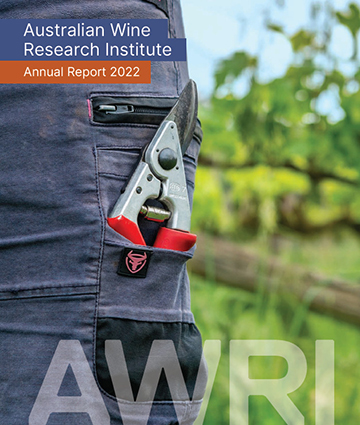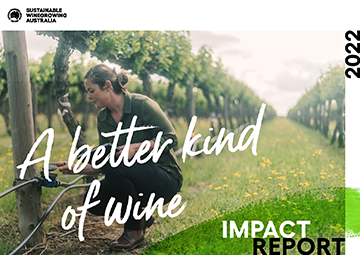22 February 2023
This season, conditions have been conducive to the development of fungal diseases. As harvest approaches, grapegrowers and winemakers across the country are under pressure to meet quality targets by managing the level of disease-affected fruit entering the winery. This eBulletin provides a reminder of the resources that are available for winemakers and grapegrowers to meet wine quality targets in a fair, equitable and mutually beneficial manner.
Disease assessment
Information about monitoring for key grapevine pest and diseases found in Australia can be found on the pests, diseases and viruses page of the AWRI website. Grape Assess is a digital monitoring tool developed by the University of Adelaide, with funding from Wine Australia, that uses visual techniques to assess diseases and disorders on grapes. Grape Assess can be downloaded for free from the Android and Apple app stores.
The Code of Conduct for Winegrape Purchases
The Code of Conduct for Winegrape Purchases was developed for the Australian wine sector by Australian Grape & Wine (AGW) and its Code Management Committee (a committee with equal representation of winemakers and grapegrowers). The Code sets minimum standards relating to grape purchasing, including mechanisms for determining price; quality assessment for the purpose of affecting price; and payment terms.
The Code is a non-prescribed voluntary industry code. Winemakers who elect to become signatories are governed by this Code in their commercial dealings with growers. Where the Code is incorporated into a contract by reference, it has contractual force. There are currently 72 signatories of the Code, representing 60-70% of the Australian winegrape crush. A list of signatories can be found here.
Grapegrowers and winemakers are encouraged to familiarise themselves with the Code to ensure they know their obligations and rights.
Fruit condition assessment
Key points from The Code related to fruit condition assessment are summarised below.
- A grower should always have the right to be present during a vineyard inspection and this should be encouraged.
- When assessing grapes against MP&C standards (mature, pure and in good condition) or grading them or otherwise making assessments of grapes, signatories must:
- (1) avoid the use of subjective measures to determine price, in circumstances where there are credible objective measures readily available to measure the same or similar characteristics;
- (2) where available, use Industry Endorsed Standard Procedures; and (3) clearly document their methodology and results, and retain that documentation.
- Notification of possible downgrading, penalties or rejection will be in accordance with timeframes laid out in the Code (for Code signatories) and in any case as early as possible with consideration to the fact that the grower may wish to seek alternative arrangements to prevent further loss. Furthermore, identifying problems as early as possible allows the grower the opportunity to take action that might avoid grapes being downgraded or rejected.
- The timing and methodology of these assessments should be specified in the grower supply agreement and, where an adverse assessment decision is made, evidence to justify the decision should be documented and be accessible to each party in the event of a dispute (this is a requirement of signatories to the Code).
Industry endorsed standard procedures
Australian Grape & Wine has produced an industry endorsed standard procedure for testing winegrapes for Brix or colour and has also produced sampling guidelines for collecting grape samples in the vineyard for Brix and colour assessment.
Although there is currently no industry-endorsed standard procedure for pest and disease assessment in the vineyard, the recently updated booklet on winegrape assessment (Hooper and Wilkes 2022) provides the following useful guidelines:
- Use the disease assessment key from Emmett et al. (2015) to quantify the percentage incidence and severity rating of disease in the vineyard.
- Commence assessment of disease in the vineyard by veraison at the latest, or earlier if resources allow.
- Conduct assessments of disease in association with the winemaker/grape purchaser.
- Ensure assessors are trained in the technical assessment of pests and diseases that can affect wine quality.
- Use an assessment method that produces results that are statistically valid, taking account of vineyard variability. Retain accurate and consistent documentation to support this.
- To ensure thorough monitoring, conduct 200 observations per ‘hot spot’ or block, stopping to assess 20 sites and assessing 10 bunches or leaves at each location by choosing one to five vines. Growers are advised, however, to consult purchasing wineries regarding their disease assessment protocols.
Dispute resolution
Information about dispute resolution can be found on the Dispute resolution page of the AGW website or by contacting the Code Secretariat on codesecretariat@accordgroup.com.au or (02) 9264 9506.
AWRI helpdesk
For assistance with grape assessment or any other technical viticulture or winemaking topic, contact the AWRI helpdesk on (08) 8313 6600 or helpdesk@awri.com.au
References and further reading
ACCC. 2019. Wine grape market study – final report.
Australian Grape & Wine Inc. 2021. Code of Conduct for Australian Winegrape Purchases.
Hooper, A., Wilkes, E. 2022. Winegrape assessment in the vineyard and at the winery.





